
6 trees that produce their foliage late
Slow to bud burst trees
Contents
Some species of trees are not in a hurry to follow their earlier “companions” in producing foliage in spring. Some trees, in fact, only begin to bud (see please note) quite late, around April or even May. This is the case with the Common Walnut or Mulberries, for example. Although this may seem concerning if one is not aware of it, it is perfectly normal and natural. These trees will thus avoid having their young leaves damaged by late spring frost.
Please note: the bud burst period is the moment when leaf buds or flower buds open to reveal the down, that is to say, the young leaves and flowers previously contained within the bud. Gardeners, botanists, and nature lovers regularly use this term in spring when the buds of deciduous trees and bushes finally open.
Common Catalpa
The Common Catalpa (Catalpa bignoniodes) is a small tree (approximately 10 m tall for the typical species) with a rapid growth rate. It is primarily grown for the shade it quickly provides, its sometimes golden foliage (as in the case of Catalpa bignoniodes ‘Aurea’) or a rounded habit (Catalpa bignoniodes ‘Nana’) depending on the cultivar, and its flowering in upright clusters occurring in May. The large heart-shaped leaves only appear late, around the end of April, sometimes early May depending on the climate.
The Chitalpa tashkentensis is a hybrid partly derived from the Common Catalpa. Its foliage also appears only at the end of April.
Very easy to grow and quite hardy, the bean tree, its nickname referring to its pod production, thrives in full sun, in any fresh, well-drained soil across most of our climates.
→ Catalpas are easy to grow as Eva explains.

Catalpa bignoniodes
Read also
6 bushes that start late in springBlack Locust
The well-known Black Locust (Robinia pseudoacacia) has been overlooked in recent years due to its thorny branches and tendency to sucker, despite its beautiful summer flowering with fragrant, melliferous clusters. Fortunately, new cultivars do not have these drawbacks, and it would be a shame not to make a little space for this elegant small tree again. These new cultivars sometimes feature pink flowering (Robinia hispida ‘Rosea’) or red (Robinia ‘Casque Rouge’), golden foliage (Robinia ‘Frisia’) or a unique, rounded habit (Robinia ‘Umbraculifera’) or dwarf and twisted (‘Twisty Baby’).
The foliage of the Robinia appears late in spring, around April, but it also falls late in autumn.
The Robinia is easy to grow, very hardy, and fast-growing. It thrives in full sun, sheltered from strong winds and salt spray. The soil should be light and well-drained, even poor.
→ Find all our tips on growing the Black Locust: planting, pruning, and maintenance.

Robinia pseudoacacia and Robinia hispida ‘Rosea’
Discover other Trees and large shrubs
View all →Available in 0 sizes
Available in 1 sizes
Available in 1 sizes
Available in 1 sizes
Available in 1 sizes
Available in 1 sizes
Available in 2 sizes
Available in 1 sizes
Available in 1 sizes
Available in 1 sizes
Mulberries
The Morus or Mulberries are charming small trees that should not be confused with brambles, also known as mulberries. Mulberries are planted in gardens as a beautiful shade tree and for the production of sweet and juicy mulberries. They grow relatively slowly, except for Morus alba in its youth, but can live for a very long time, sometimes up to 500 years.
Mulberries are probably the last trees to produce their leaves, around the beginning of May, which helps them avoid issues with late spring frosts. This may be why the Mulberry is a symbol of wisdom and patience.
Trees of a mild climate, mulberries are nevertheless quite hardy and remarkably drought-resistant. They should be grown in full sun and in well-drained soils.
→ All the best growing tips for Morus, Mulberry can be found here.
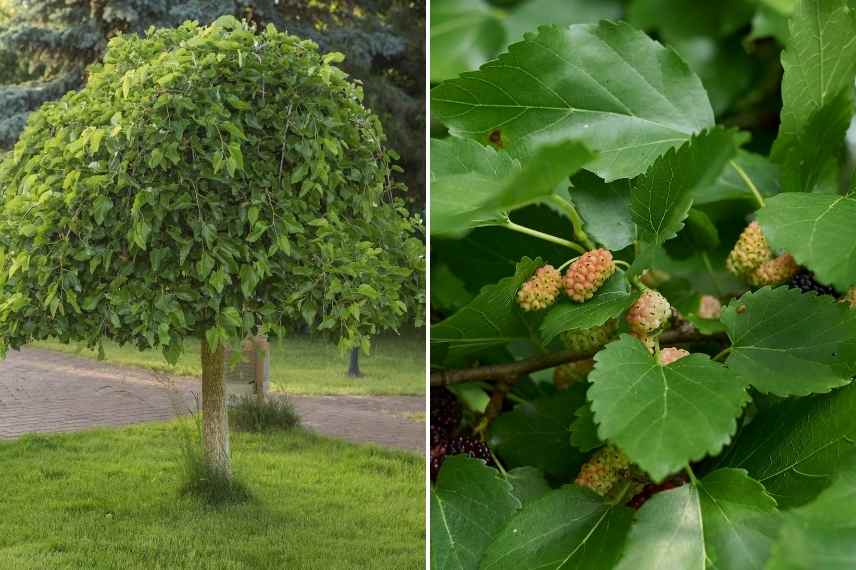
Morus alba ‘Pendula’ and foliage of Morus alba
Read also
6 late-flowring spring perennialsSamarian Elm
Samarian Elm (Ptelea trifoliata) is a small deciduous tree (6 m tall), belonging to the citrus family, which bears lovely clusters of winged fruits resembling those of the elm, decorative until late in the season. The spring flowering, although subtle, is fragrant and melliferous.
Its trifoliate foliage only develops during the month of April. The leaves are a beautiful dark green before turning a golden yellow in autumn, revealing a fragrance of lemon and musk when crushed.
The Ptelea is also extremely accommodating: it tolerates shade well and adapts to poor, shallow, rocky soils, even slightly calcareous and dry in summer once well established. A small tree, rare in cultivation, worth trying in your garden!

Ptelea trifoliata
Ginkgo biloba
The Ginkgo tree or Ginkgo biloba is an extraordinary tree in more ways than one. Related to conifers and the only living representative of a very ancient botanical family, this tree has a very graphic deciduous leaf that takes on a sumptuous golden colour in autumn. The typical species becomes a large tree over time, but there are now dwarf or more compact cultivars: ‘Mariken‘ or ‘Troll‘.
The Ginkgo produces its foliage from April, sometimes even only at the very beginning of May, but this primarily depends on the sex of the tree. Indeed, a male individual will cover itself in leaves about 15 days before a female plant.
The Ginkgo biloba is not particularly fussy about soil type: any good fertile, deep, and well-drained soil will do. It thrives in full sun, withstands urban pollution well, and is never sick or attacked by parasites.
→ Want to know more about this fascinating tree? Read Ginkgo biloba: planting, care, and uses.
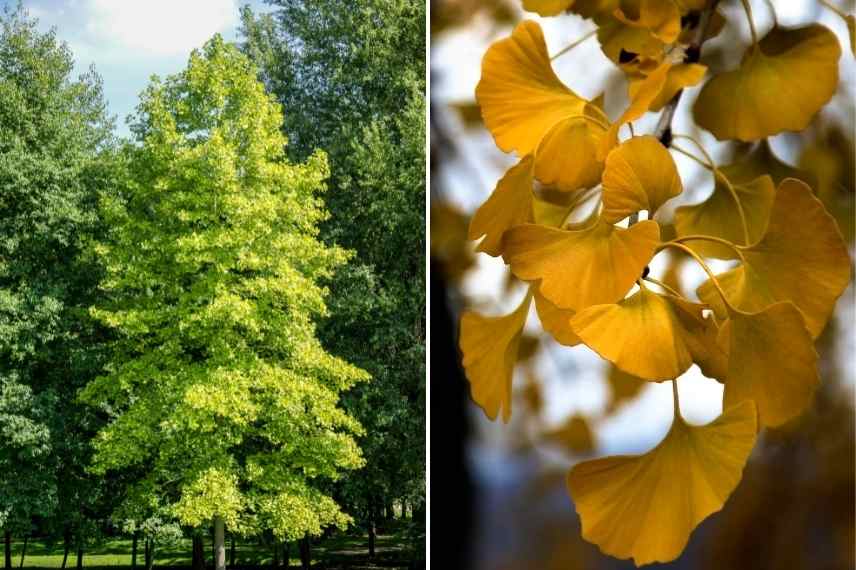
Ginkgo biloba habit, and to the right autumn foliage
Common Walnut
The Common Walnut (Juglans regia) is a well-known tree among walnut enthusiasts, although it can take over 10 years before you can enjoy its nuts. Nevertheless, it is a beautiful, stout tree that can reach around fifteen metres in height and has a long lifespan. Its lovely foliage is formed of ovate leaflets.
The walnut produces its flowers in April before the leaves appear in May. These flowers can be destroyed in the North of the Loire by late frosts, which can wipe out walnut production. In this case, opt for a variety with later flowering and ripeness, such as the ‘Fernor’ Common Walnut. For better production, do not hesitate to plant at least two walnuts.
Very hardy, the walnut grows in neutral to alkaline soil, in a sunny position.
→ Walnut, Juglans regia: planting, pruning, and care.
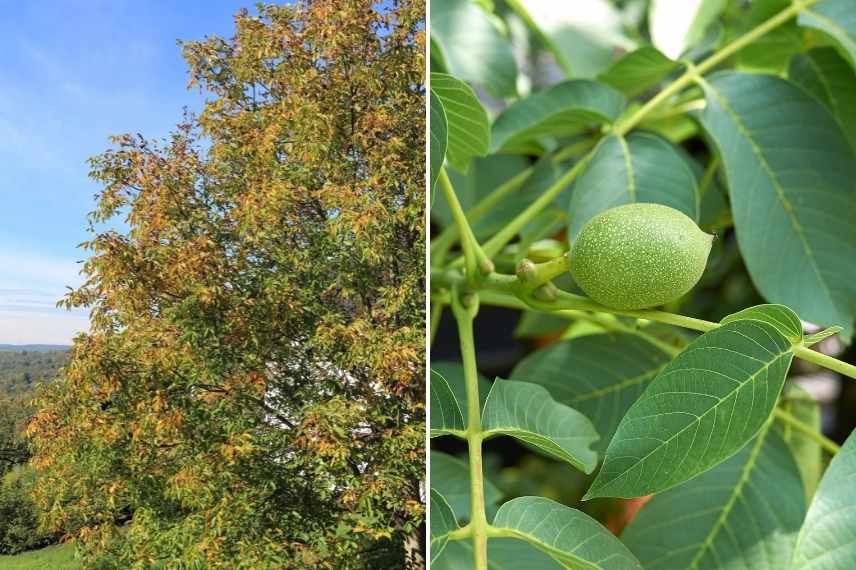
Juglans regia
- Subscribe!
- Contents


































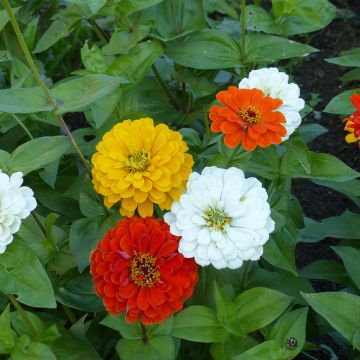



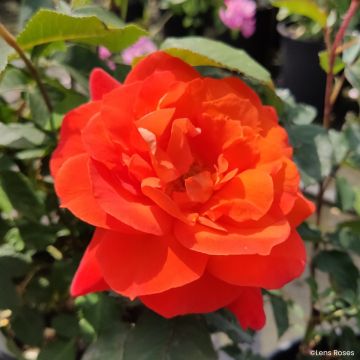

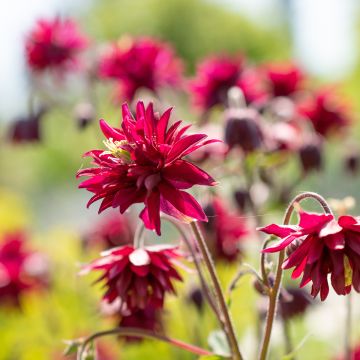

Comments